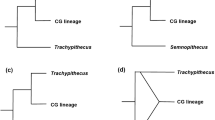Abstract
Numerous morphology-based classification schemes have been proposed for langurs and leaf monkeys of South Asia but there is very little agreement between them. An incorrect classification scheme when used as a basis for biogeographic studies can support erroneous hypotheses. Further, lack of taxonomic resolution will also confound conservation efforts, given that conservation biologists use traditional morphology-based-classification schemes to prioritize species for conservation. Here, I have revisited recent molecular phylogenetic studies done on langurs and leaf monkeys of South Asia. Results from these studies are in turn used to derive a rational and scientific basis for prioritizing species for conservation. Molecular data support the classification of langurs of the Indian subcontinent—Hanuman, Nilgiri and purple-faced langurs—in the genus Semnopithecus, whereas Phayre’s leaf monkey along with other Southeast Asian leaf monkeys form another distinct clade (Trachypithecus). The phylogenetic position of capped and golden langurs remains unresolved. Molecular data suggest that they are closely related to each other but this group might have evolved through past hybridization between Semnopithecus and Trachypithecus. Additionally, genetic data also support the splitting of the so-called Hanuman langurs into at least three species. The scores for taxonomic uniqueness of langurs and leaf monkeys of South Asia were revised using this molecular phylogeny-based classification. According to the revised scores, Phayres leaf monkey and golden langur are priority species for conservation followed by capped and Nilgiri langurs.
Similar content being viewed by others
References
Brandon-Jones D., Eudey A. A., Geissmann T., Groves C. P., Melnick D. J., Morales J. C. et al. 2004 Asian primate classification. Int. J. Primatol. 25, 97–162.
Chivers D. J. and Hladik C. M. 1980 Morphology of the gastrointestinal tract in primates: comparisons with other mammals in relation to diet. J. Morphol. 166, 377–386.
Disotell T. R. 2000 Molecular systematics of the Cercopithecidae. In Old world monkeys (ed. P. F. Whitehead and C. J. Jolly) pp. 29–56. Cambridge University Press, Cambridge, UK.
Eudey A. A. 1987 Action plan for Asian primate conservation: 1987–1991. IUCN/SSC primate specialist group, Gland, Switzerland.
Groves C. P. 1989 A theory of human and primate evolution. Clarendon Press, Oxford, UK.
Groves C. P. 2001 Primate taxonomy. Smithsonian Institute Press, Washington, USA.
Karanth K. P. 2003 Evolution of disjunct distribution among wet zone species of the Indian subcontinent: testing various hypothesis using a phylogenetic approach. Curr. Sci. 85, 101–108.
Karanth K. P. 2008 Primate numts and reticulate evolutions of capped and golden leaf monkeys (Primates: Colobinae). J. Biosci. 33, 761–770.
Karanth K. P., Singh L., Collura R. and Stewart C.-B. 2008 Molecular phylogeny and biogeography of the langurs and leaf monkeys. Mol. Phylogenet. Evol. 46, 683–694.
Karanth P. K., Singh L. and Stewart C.-B. 2010 Mitochondrial and nuclear markers suggest Hanuman langur (Primates: Colobinae) polyphyly: implications for their species status. Mol. Phylogenet. Evol. 54, 627–663.
Morales C. J., Disotell T. R. and Melnick D. J. 1999 Molecular phylogenetic studies of nonhuman primates. In The nonhuman primates (ed. P. Dolhinow and A. Fuentes), pp. 18–38. Mayfield publishing company, mountain view, USA.
Napier J. R. and Napier P. H. 1985 The natural history of the primates. MIT Press, Cambridge, USA.
Newton P. N. 1988 The variable social organization of Hanuman langur (Presbytis entellus), infanticide, and the monopolization of females. Int. J. Primatol. 9, 59–77.
Oates J. F. 1985 Action plan for African primate conservation: 1986–90. IUCN/SSC Primate Specialist Group, Gland, Switzerland.
Oates J. F., Davies A. G. and Delson E. 1994 The diversity of living colobines. In Colobine monkeys: their ecology, behaviour and evolution (ed. A. G. Davies and J. F. Oates) pp. 45–73. Cambridge University Press, Cambridge, UK.
Osterholz M., Walter L. and Roos C. 2008 Phylogenetic position of the langur genera Semnopithecus and Trachypithecus among Asian colobines, and genus affiliations of their species groups. BMC Evol. Biol. 8, 58.
Padmanabhan P. and Gadgil M. 2000 What to conserve: an objective and participatory method. In Setting biodiversity conservation priorities for India (ed. S. Singh, A. R. K. Sastry, R. Mehta and V. Uppal) pp. 426–444. World Wide Fund for Nature, New Delhi, India.
Roonwal M. L. 1984 Tail form and carriage in Asian and other primates, and their behavioral and evolutionary significance. In Current primate research (ed. M. L. Roonwal, S.M. Mohnot and N. S. Rathore) pp. 93–151. Jodhpur University Press, Jodhpur, India.
Wangchuk T. Inouye D. W. and Hare M. P. 2008 The emergence of an endangered species: evolution and phylogeny of Trachypithecus geei of Bhutan. Int. J. Primatol. 29, 565–582.
Author information
Authors and Affiliations
Corresponding author
Rights and permissions
About this article
Cite this article
Praveen Karanth, K. Molecular systematics and conservation of the langurs and leaf monkeys of South Asia. J Genet 89, 393 (2010). https://doi.org/10.1007/s12041-010-0057-3
Received:
Revised:
Accepted:
Published:
DOI: https://doi.org/10.1007/s12041-010-0057-3




